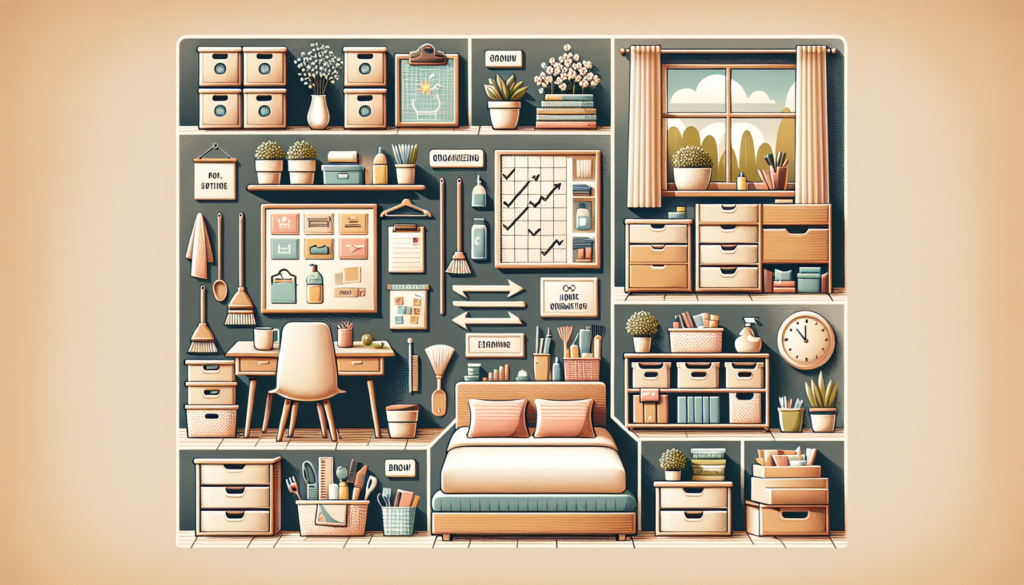Beginning the journey of organizing one’s home can seem like a daunting task, yet it is an essential step towards creating a calming and functional living space. Knowing where to start organizing your home is crucial for anyone eager to transform their chaotic environments into havens of serenity and order. This transformative process not only enhances the aesthetics of your living space but also brings about an elevating sense of mental clarity and efficiency. By embarking on this endeavor, homeowners can reflect on their personal goals and the feelings they aspire to evoke within their spaces, recognizing that the physical arrangement around them can significantly influence their daily life and well-being.
The primary objective of this article is to guide homeowners on how to organize their homes effectively while mitigating the overwhelming aspects often associated with such tasks. It will offer a step-by-step approach for each room, integrating tips and tricks that cater to the diverse needs and preferences of household members. We’ll cover essential strategies such as setting achievable goals, preparing for the organization process, and the fundamental act of decluttering which serves as the backbone for any organizational endeavor. You will learn how to organize your home through tailored techniques that consider the uniqueness of every space, along with practical advice on maintaining the newfound order. By introducing the tenants of reducing, being resourceful, and fostering resilience, we’ll aim to not only aid in how to get organized at home but also how to sustain these habits over time.
Setting Achievable Goals
When considering where to start organizing your home, setting clear and achievable goals is the first step to success. Here’s how to establish SMART goals to guide your home organization journey:
- Identify Priorities
- Start by pinpointing the area in your home that causes the most stress due to disorganization.
- Decide on a specific, measurable outcome, such as reducing the contents of a cluttered space by 30%.
- Create a Realistic Plan
- Break down larger tasks into smaller, more manageable ones to avoid feeling overwhelmed. For example, if tackling the kitchen, start with one drawer or cabinet at a time.
- Use a calendar to schedule organization sessions, dedicating time slots to focus solely on organizing tasks.
- Set deadlines for each task to maintain momentum and track progress.
- Implement and Review
- Regularly assess your goals and the progress made, adjusting your plan as necessary.
- Celebrate small victories to stay motivated. For instance, reward yourself after completing the organization of a particular area.
- Involve family members in the process, ensuring everyone understands where items belong and participates in maintaining the organization.
Tips for Effective Goal Setting:
- Quantify Your Goals: For example, aim to donate 20 books or throw away all expired pantry items.
- Space and Purpose: Measure your storage spaces and decide the purpose of each room, keeping only what fits and aligns with the room’s function.
- Master Delegation: Be honest about tasks you prefer to handle yourself and those you can delegate.
- Decluttering: Remove items that are broken, expired, or no longer wanted to free up space.
- Systemize: Organize areas using tools like drawer dividers and ensure each item has a designated place.
Record Keeping
Write down your goals, break them into steps, and keep a journal of your organizing journey to visualize progress.By incorporating these strategies, you’ll learn how to organize your home in a way that’s tailored to your lifestyle, making the process of getting organized at home both achievable and sustainable. Remember to respect your space and the limits it presents; not everything can or should be kept. With SMART goals in place, you’ll be well on your way to creating a more orderly and peaceful home environment.
Setting the Stage: Preparing to Organize
Before diving into the heart of organizing your home, it’s essential to set the stage for a successful session. Here’s how to prepare:
Prepare Yourself
- Ensure you’re well-rested before beginning; tackling disorganization requires energy and focus.
- Dress in comfortable clothing that allows you to move around freely—think flexible and breathable fabrics.
- Have snacks and water on hand to keep your energy levels steady without needing to interrupt the session for meal breaks.
Create an Optimal Environment
- Schedule your organizing time when you can minimize interruptions. Turn off notifications on your phone and set specific times for checking emails or taking calls.
- If possible, arrange for children to be engaged in another activity or out of the house to ensure you can concentrate fully on the task at hand.
Establish a Realistic Perspective
- Resist the urge to tidy up before you start. It’s important for the space to be in its natural state to accurately assess what systems will work best.
- Visualize the end result of your organizing efforts. Keeping a clear image of your ideal space in mind can motivate you through challenging parts of the process.
- Communicate your vision and goals with any professional organizer you are working with. They are there to support, not judge, and can tailor their approach to your specific needs.
Practical Steps for the Organizing Session
- Begin by discarding items that are outdated, never used, or expired to clear space and make organization easier.
- Invest in storage solutions that fit your lifestyl
- Use containers and drawer organizers for grouping similar items together.
- Label items clearly so everyone in the home knows where things belong.
- Establish a daily three-minute routine to maintain organization and prevent clutter from building up again.
- When shopping, stick to a list to avoid bringing unnecessary items into your home.
- Set regular times for routine tasks, such as paying bills, to prevent paperwork from piling up.
Consider using timers to keep your organizing sessions focused and productive. If needed, enlist the help of a professional organizer or even neighborhood kids for tasks like sorting and labeling.By taking these steps to prepare, you’re not just organizing your home—you’re setting up systems and habits that will help keep it organized long-term. Remember, knowing where to start organizing your home is as much about preparation as it is about the actual organizing.
Decluttering: The Foundation of Organization
Decluttering is not just about creating space but also about enhancing the quality of your living environment. When considering where to start organizing your home, decluttering should always be the first step. The benefits are numerous: less to clean, less to organize, which leads to less stress, and ultimately, it can contribute to more financial freedom by curbing the urge to buy more.
Starting Small:
- Begin with a manageable approach: dedicate just 5 minutes each day to decluttering or make it a habit to donate one item daily.
- Encourage children to participate by having them select a toy to donate or help with a 10-minute tidy-up before bedtime.
The Four-Box Method:
- To effectively sort through items, use the Four-Box Method by labeling boxes as: Keep, Donate, Store, or Discard.
- Make it a regular practice to review and remove items from these boxes, particularly those designated for donation or discarding.
Maintaining Clutter-Free Spaces:
- Implement a toy rotation system to limit the number of toys in use and encourage proper storage.
- Install hooks for coats and a designated area for shoes to teach children the importance of organization from a young age.
- Keep a bag in closets for clothes that no longer fit, making it easy to donate when it’s full.
Evening Routine:
- Spend a final 10 minutes each evening for a quick clean-up, ensuring the home is reset for the next day.
Decluttering by Area:
- Tackle clutter by focusing on one area at a time, creating peaceful spaces that are free from unnecessary items.
- Use the “Ex Test” by asking yourself if you would choose to buy an item again today; if the answer is no, it may be time to let it go.
- Set limits on how much space a particular category of items can occupy.
Before Buying Organizers:
- Avoid purchasing containers or organizers until after you’ve decluttered; this ensures you only buy what you truly need.
- Acknowledge that if you never liked something, chances are you won’t start liking it now. It’s okay to let go.
Avoiding Common Pitfalls
Be wary of keeping items out of a sense of obligation or perceived value; long-term ownership does not equate to necessity.By integrating these decluttering methods into your routine, you will not only know how to organize your home but also how to get organized at home in a way that is sustainable and tailored to your lifestyle. These steps will pave the way for a more orderly home environment, setting a strong foundation for the organizational systems you will put in place in each room.
Organizing Techniques for Every Space
When considering where to start organizing my home, employing specific techniques tailored to each space can significantly enhance the effectiveness of your efforts. Here are some methods to apply:
Living Room
- Storage Furniture: Opt for multi-functional furniture such as ottomans and coffee tables with built-in storage to neatly tuck away blankets, board games, and books.
- Declutter and Categorize: Before storing, sort through items, declutter, and group like-with-like. Use bins or containers to house similar items and label them for easy identification.
- Visual Appeal: Color code collections for an organized display that also serves as a decorative element.
Kitchen/Pantry
- Spice and Ingredient Organization: Transfer spices and cooking ingredients into matching jars with labels for a uniform look and easy access.
- Vertical Storage Solutions: Install shelves to store items like cutting boards and baking pans upright, saving counter space and keeping them within reach.
- Pot Rail: Use a pot rail to hang pots and utensils, which not only saves space but also puts your kitchen essentials on display for ease of use.
Bedroom
- Closet Organization: Use sliding drawers, storage baskets, and ensure sufficient vertical space for hanging and storing clothes. Consider adding shelf risers in cabinets to double storage for plates and mugs.
- Nightstand Management: Keep nightstands clear by using trays as catchalls for daily essentials.
- Under-the-Bed Storage: Utilize the space under the bed with storage containers for seasonal clothing or extra bedding.
Bathroom
- Under-Sink Organization: Install pull-out drawers or bins under the sink to make use of this often-wasted space. Relocate items that don’t belong to more appropriate spots.
- Drawer Dividers: Use dividers to keep small items separated and prevent drawers from becoming cluttered.
- Vertical Space: Hang floating shelves to store everyday items within arm’s reach and maximize wall space.
Home Office
- Command Center: Create a space in your home office for essential documents and supplies. Use wall-mounted magazine files to store important papers and create a system for incoming and outgoing items.
- Habit Formation: Implement goal-setting and regular routines to maintain organization, like a weekly desk cleanup or paper sorting.
Playroom
- Internal Container Use: Place smaller containers within larger ones to keep toy categories separate and manageable.
- Vertical Storage: Use shelves to store books and games, and clear bins for toys to easily see and access contents.
General Storage Spaces
- Outdoor Item Storage: Store outdoor items by category in weather-resistant containers to keep them protected and organized.
- Use of Pegboards: Install pegboards to hang tools, craft supplies, or jewelry, which makes use of wall space and keeps items visible.
Laundry Room
- Laundry Product Organization: Keep detergents, fabric softeners, and other laundry products in designated containers for a neat appearance.
- Hamper System: Use divided hampers to pre-sort laundry, saving time on wash day.Remember, the key to how to organize your home is consistency and adaptability. Regularly reassess and adjust your organizing systems, ensuring they continue to meet your needs. By breaking down the project room by room and applying these specific techniques, you will not only learn how to get organized at home but also how to maintain it.
Maintaining Your Organized Home
To maintain the orderliness of your home after figuring out where to start organizing, it’s essential to incorporate daily habits and efficient systems. These strategies will enable you to sustain a clutter-free and well-arranged environment:
Daily Habits for Sustained Organization
- Morning Routine:
- Make your bed immediately upon rising to instill a sense of order from the start of the day.
- Empty the dishwasher every morning to keep kitchen counters clear and ready for use.
- Evening Rituals:
- Dedicate 20 minutes each evening to declutter various spaces, preventing accumulation.
- Conduct a nightly tidy-up, resetting your space for the next day.
- Spot-clean bathrooms to maintain cleanliness without the need for frequent deep cleans.
Efficient Systems for Home Management
- Mail and Paperwork:
- Immediately deal with incoming mail to avoid piles of unsorted papers.
- Adopt a weekly scan-and-trash routine to minimize paper clutter.
- Laundry and Cleaning:
- Start a load of laundry before work to manage household chores effectively.
- Clean out the fridge every week to discard expired items and maintain hygiene.Involvement and Mindfulness:
- Encourage all household members to participate in maintaining organization, ensuring a team effort.
- Regularly purge unnecessary items to keep spaces uncluttered.
- Be mindful of purchases, limiting impulse buys to prevent excess accumulation.
By integrating these practices, you’ll not only learn how to organize your home but also how to get organized at home in a way that’s sustainable and manageable. These actionable steps will help you keep each room in your home in top shape, reflecting the initial effort you put into organizing your space. Remember, the key to how to organize my home is not just in the initial sorting and arranging but in the ongoing commitment to maintaining the systems you’ve put in place.
FAQs
Q: How should I begin organizing my room?
A: Start by categorizing your belongings: group similar items together and decide what to keep and what to let go of. Make sure you have the necessary storage solutions to put everything away in an orderly fashion. Begin organizing on a larger scale before focusing on the details.
Q: What sequence should I follow to organize my house efficiently?
A: The suggested sequence for organizing your home is as follows:
- Conduct a walkthrough of your entire house.
- Clear out and organize storage areas first.
- Perform a deep cleaning of the house.
- Refresh and declutter bathrooms.
- Organize the pantry.
- Reorganize the kitchen.
- Arrange smaller spaces effectively.
- End with areas that are used less frequently.
Q: What are the initial steps to organize my house?
A: Begin by eliminating any trash. Start small, perhaps with a single drawer, and sort your items into three categories: keep, donate, or throw away. Ensure every item you decide to keep has a designated place in your home.
Q: How can I start organizing if I’m overwhelmed and unsure of where to begin?
A: To tackle organization when feeling overwhelmed, support yourself emotionally and set a clear vision for what you want to achieve. Write down your organizational goals and understand your motivations. Involve others for accountability and assistance. Take it one step at a time, ask yourself critical questions about each item’s necessity, and make sure you have the right organizational tools.
Q: Which area should I declutter first in my home?
A: Begin decluttering with the most frequently used area of your home, such as the kitchen or family room. Go through the process of deciding what to keep, discard, or donate.
Q: Can you provide some tips for organizing a bedroom?
A: Here are some effective bedroom organizing tips:
- Tackle one section at a time.
- Invest in a closet organizer.
- Use dividers for drawers and shelves.
- Use a shoe rack to keep footwear organized.
- Get a jewelry organizer to avoid tangles.
- Use specific storage solutions for clothes, hats, and other items.
Q: What is the quickest method to organize a cluttered house?
A: To quickly declutter your home, follow these steps:
- Identify what you want to declutter.
- Plan your decluttering day.
- Sort items into keep, donate, or toss piles.
- Make decisions on what to pass on.
- Determine what to keep.
- Dispose of unwanted items promptly.
- Use storage solutions effectively.
- Establish an organizational system.
Q: What are the steps to organize my bedroom methodically?
A: To organize your bedroom step by step:
- Start with a general tidy-up.
- Take stock of your belongings.
- Put items in their proper place.
- Clear off your bedside table.
- Organize your dresser drawers.
- Choose a closet organization system.
- Look into additional storage options.
- Finish with a thorough cleaning.
Q: Which room should I prioritize when starting to declutter?
A: Consider organizing the room where you spend the most time first.
Q: What are some common mistakes to avoid when organizing?
A: Avoid organizing without a plan. Don’t just stuff items randomly into drawers or closets. If you have a “junk drawer” that tends to become cluttered, it’s time to find a better organization solution for those items.



